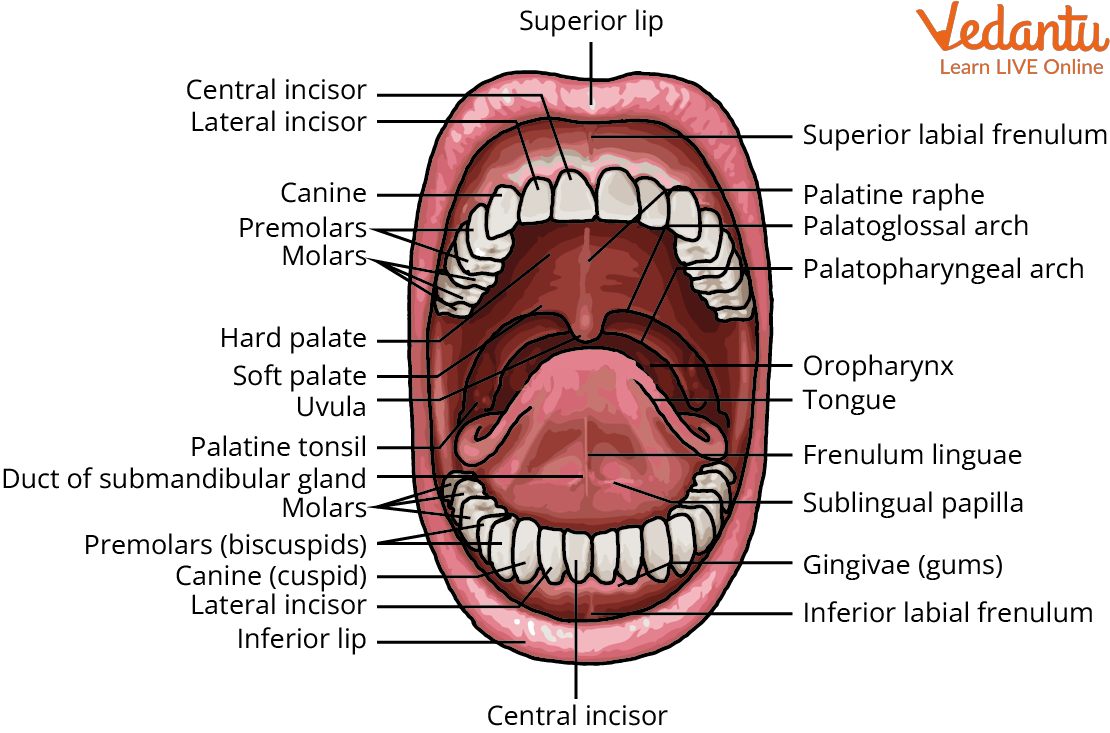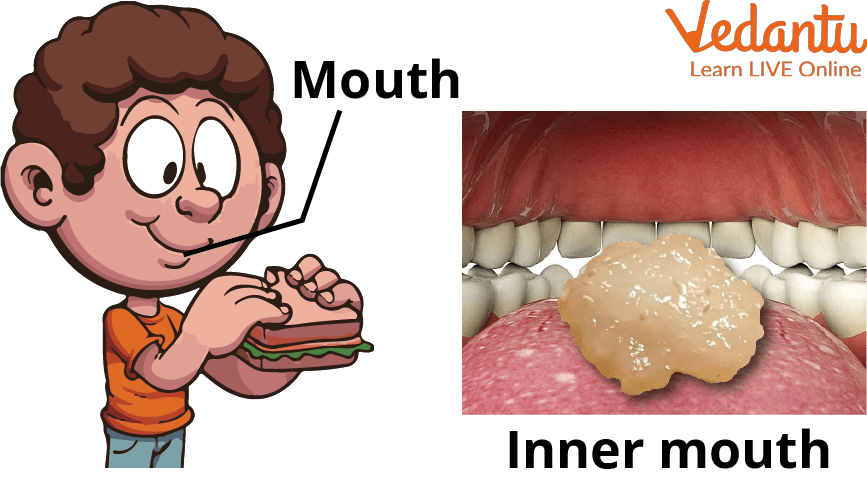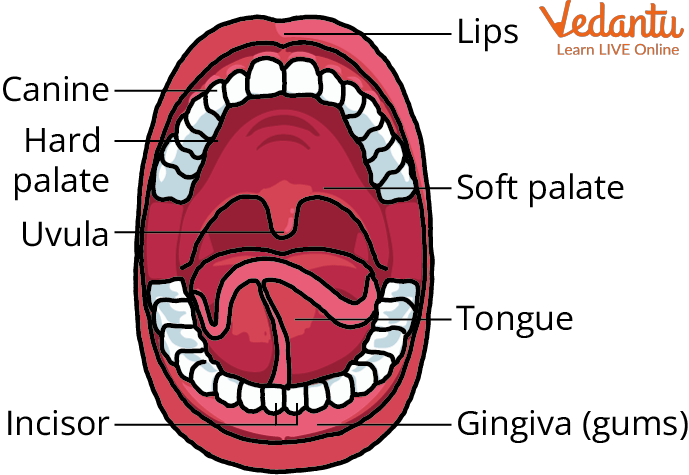




Introduction to Different Parts of the Mouth
The mouth is a cavity inside the skull which is oval in shape. The mouth's two primary functions are eating and speaking. The lips, vestibule, mouth cavity, gums, teeth, hard and soft palate, tongue, and salivary glands are all parts of the mouth. The oral cavity or buccal cavity are other names for the mouth. Eating, speaking, breathing, digesting food, and smiling are all activities. It consists of many components. Some are complex.
Cheeks and Lips
This dynamic duo consists of powerful muscles. They enable you to smile, frown, kiss and communicate. They also serve as a guide to keeping your teeth in the proper position.
Tongue
You can thank your tongue the next time you say, "That's delicious!" It, along with other parts of your mouth, contains approximately 10,000 taste buds, allowing you to taste sweet, savoury, salty, and bitter flavours.

Parts of the Mouth
However, your tongue serves multiple functions, including speaking, chewing, and swallowing.
Alveolar Bone, Teeth, and Gums
Here's something to be cheerful about and with Your pearly whites. They are made of hard enamel with roots that connect to your jawbone. The alveolar bone surrounds the roots and aids in the retention of your teeth. Your gums hold everything together, preventing your teeth and roots decay.
Glands of Saliva
Your salivary glands are responsible for producing (you guessed it) saliva. This aids digestion by breaking down food and putting moisture in your mouth so you can speak, chew, and swallow. Saliva also aids in the prevention of cavities and gum disease by repeatedly washing bacteria from your teeth and gums. There are three pairs of main salivary glands and hundreds of minor ones in your body. Your salivary glands play an essential role in chewing, swallowing, and maintaining proper oral hygiene. They can be found in your head and neck. Two parotid glands (the largest), two submandibular glands, and two sublingual glands are among the three major glands. In addition, minor salivary glands can be found all over your oral cavity, including your cheeks, mouth, palate, and sinuses.
TMJ (Temporomandibular Joint)
The temporomandibular joints enable you to open and close your mouth and move your lower jaw forward and side to side. These two joints also help you speak, chew and swallow.
Tips for Maintaining the Health of Your Oral Cavity
A good oral hygiene routine. Brush and floss your teeth twice daily.
Maintain regular appointments with your dental professionals.

Inner Mouth
How to Keep the Teeth Healthy
Offer a wholesome diet. Reduce your intake of juice, sweet snacks, and sticky foods like dried fruit.
Attend routine dental examinations.

Parts of the Oral Cavity
Assist younger children in twice-daily, two-minute tooth-brushing. Then, when the teeth are in contact, encourage your youngster to begin flossing once per day.
In sports where there is a chance of mouth injury, insist that your child wear a mouthguard.
Teach your kid never to run or walk with anything in their mouth, such as a pencil or a toothbrush.
If your child is still sucking their thumb or using a pacifier by the time they turn four, consult a doctor or dentist. They can provide you with advice on how to get your child out of the habit.
Summary
From the article, as mentioned earlier, we can make the children aware that the human mouth is divided into several sections. The lips encircle the outside of the mouth. The cheeks form the sides of the mouth, and the bottom by the floor. Small tubes in the foot and cheeks allow saliva to enter the mouth. The upper part of the mouth is called the roof. It consists of two parts.
On the front, there is flesh covering the bone. The back part is soft flesh. The uvula is a small piece of meat that hangs from the roof of the mouth in the back. Two teeth grow from the top and bottom of the mouth, behind the lips. Before swallowing food, a person chews it with their teeth. The tongue helps make speech sounds. Gums cover the teeth and attach them to the jawbone.
FAQs on Parts of the Mouth: Learn and Explore the Anatomy
1. What are the main parts of the human mouth?
The human mouth, also known as the oral cavity, is composed of several key parts that work together. The main components include:
- Lips and Cheeks: Form the entrance and sides of the mouth, helping to hold food and assist in speech.
- Teeth: Used for cutting, tearing, and grinding food in a process called mastication.
- Tongue: A muscular organ used for tasting, manipulating food for chewing and swallowing, and articulating speech.
- Palate: The roof of the mouth, divided into the bony hard palate at the front and the fleshy soft palate at the back.
- Salivary Glands: Produce saliva to moisten food, begin digestion, and keep the mouth clean.
- Uvula: The small, fleshy projection that hangs from the back of the soft palate.
2. What is the function of each part of the mouth?
Each part of the mouth has a specific and vital function. For example, the teeth begin mechanical digestion by breaking down food. The tongue manipulates this food, mixes it with saliva, and initiates swallowing. Saliva, produced by the salivary glands, starts chemical digestion with enzymes and lubricates the food. The palate separates the oral cavity from the nasal cavity and provides a surface against which the tongue can work. Finally, the lips and cheeks help contain the food and are essential for forming words during speech.
3. What are the four different types of teeth and what do they do?
Humans have four distinct types of teeth, each structured for a specific task in eating:
- Incisors: The sharp, chisel-shaped front teeth (four on top, four on bottom) used for cutting and biting food.
- Canines: The pointed teeth located next to the incisors, used for tearing and ripping tougher foods like meat.
- Premolars (Bicuspids): Found between the canines and molars, they have flatter surfaces for crushing and grinding.
- Molars: The large teeth at the back of the mouth with broad, flat surfaces designed for the final, heavy-duty grinding of food before it is swallowed.
4. What is the role of the tongue beyond just tasting food?
While the tongue is famous for its taste buds, its function is far more complex. It is a highly agile and strong muscle that plays a crucial role in:
- Mastication (Chewing): The tongue repositions food between the teeth to ensure it is thoroughly chewed.
- Deglutition (Swallowing): It shapes the chewed food into a ball, called a bolus, and pushes it to the back of the mouth to initiate swallowing.
- Speech (Articulation): The tongue's precise movements against the teeth and palate are essential for forming the sounds that make up words.
5. How do the hard and soft palates differ in structure and function?
The hard and soft palates form the roof of the mouth but have distinct structures and roles. The hard palate is the fixed, bony section at the front. Its rigid, ridged surface provides a firm platform for the tongue to press food against during chewing. In contrast, the soft palate is the movable, fleshy part at the back. Its primary function is to rise during swallowing, acting like a valve to close off the nasal passages and prevent food or liquid from entering the nose.
6. Why is saliva so important for oral health and digestion?
Saliva's importance extends far beyond simply moistening the mouth. It is critical because it:
- Starts Chemical Digestion: It contains enzymes like amylase, which begins the breakdown of carbohydrates right in the mouth.
- Lubricates Food: It moistens food, making it easier to chew and form into a bolus for safe swallowing.
- Protects Teeth: Saliva neutralises acids produced by bacteria, helping to prevent tooth decay, and contains minerals that strengthen tooth enamel.
- Enables Taste: It dissolves food particles, allowing the chemical compounds to be detected by the taste buds on the tongue.
7. How do the different parts of the mouth coordinate to help us speak?
Speech, or articulation, is a complex process requiring precise coordination between several parts of the mouth. Airflow from the lungs is shaped into specific sounds by the actions of the tongue, lips, and teeth. The lips can be rounded or spread to form vowel sounds and closed to create consonants like 'p' and 'b'. The tongue makes contact with the teeth (for 'th' sounds) or the palate (for 'k' or 'd' sounds) to obstruct or modify the airflow, creating the vast range of sounds used in language.
8. What are the key anatomical structures located under the tongue?
The area under the tongue, known as the floor of the mouth, contains several important structures. The most prominent is the lingual frenulum, a small fold of tissue that anchors the tongue to the floor of the mouth. Also present are the openings of the submandibular and sublingual salivary glands, which release saliva into this area. This region has a very rich blood supply, which is why some medications are placed under the tongue for rapid absorption directly into the bloodstream.
9. What is the difference between the oral cavity and the buccal cavity?
In anatomical terms, the 'oral cavity' is the entire mouth. It is technically divided into two parts. The buccal cavity, or oral vestibule, is the outer space between the cheeks and lips on one side, and the teeth and gums on the other. The oral cavity proper is the main space inside the arch of the teeth, containing the tongue. While people often use 'oral cavity' to mean the whole mouth, 'buccal cavity' specifically refers to this cheek area.









